These devices are one of the most advertised and charlatan to date. They were initially based on a constructive scheme that does not take into account the basic technological principles of distillation. Manufacturers played on the naivety and faith of consumers in a miracle. With a depressingly low productivity, moonshine has much more harmful impurities than a drink obtained by traditional methods (on a distiller with a coil). There are no chances to complete, reconstruct or modernize the double distillation apparatus (first generation). However, let’s not be unfounded, we will step by step analyze the work and design flaws.
Brands and brands. As of March 2018, the review is relevant for models:
- Gorilych (ADP);
- “Spirtovar”, “Spirtovar 2” (Magnum 2018), “Spirtovar Pro Plus”, “Spirtovar Istomina”;
- “Hop-master”;
- “Ural” double distillation with 2 and 4 bubblers;
- “Robin” Double blow;
- “Buddy”;
- and other devices operating on the same principle.
In most cases, buyers deal with the products of the Chelyabinsk Distillation Apparatus Plant (CHZDA), which are sold under other names and brands. The enterprise itself marks this series of distillers with the abbreviation ADP (double distillation apparatus). Sometimes other sellers make “cosmetic” changes to the design that do not affect the operation and the final result.
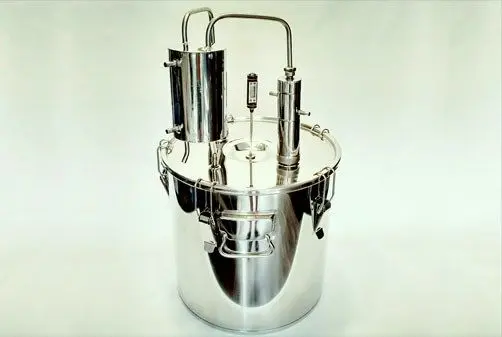
Concept and principle of work
The figure shows a schematic diagram of the first generation double distillation apparatus. The author of the design is considered to be Sergey Istomin, who invented his “Spirtovar” in the 80s of the last century. Istomin at that time was an employee of the Kurchatov Research Institute, which played a significant role in promoting this device to the market. A wonderful story for advertising: a talented nuclear physicist, together with colleagues, creates the best moonshine still of all times and peoples in a closed scientific laboratory. However, in reality, this scheme has a number of significant drawbacks.
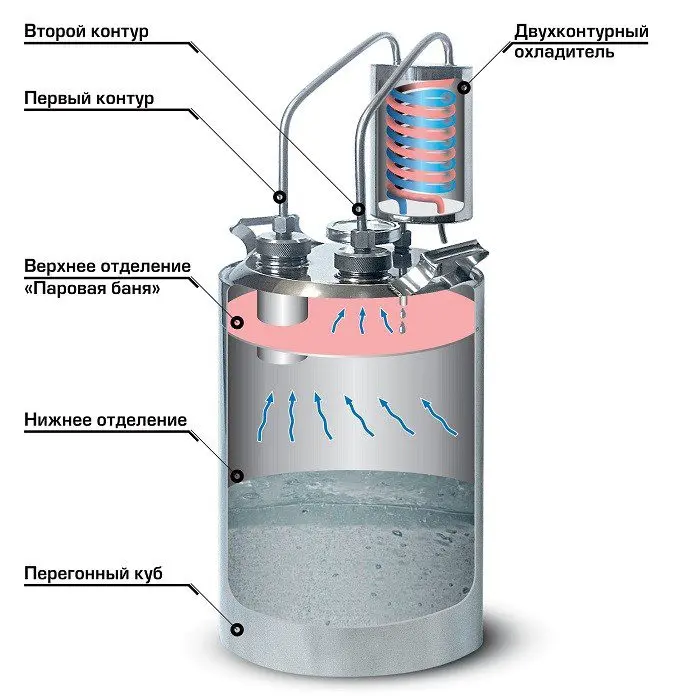
When the cube is heated, alcohol-containing vapor enters the first circuit of the flow cooler, from there the condensed distillate flows into the steam bath (upper compartment), where it is again heated from the heat of the lower compartment and turns into alcohol-containing vapor, which enters the second circuit of the cooler, where it condenses again and through the drain tube enters the receiving container.
The basic design of the device changed in accordance with the requirements of the market, without improving it in any way, but as we will analyze a little lower, even worsening its characteristics:
- small dry steamers appeared, since the annoyingly low performance of the device simply forced users to try to increase the heating power, as a result, foam and splashes fell into the steam bath, and from there into the selection.
- paying tribute to the established stereotypes, dry steamers turned into jacketed dephlegmators, and then into imitation of packed columns with on-load tap changers and shell-and-tube dephlegmators.
- in response to complaints from customers that the apparatus is unsuitable for anything other than sugar mash, as it is difficult to wash, manufacturers responded with new models, for example, “Spirtovar” simply used a standard pan, attaching a steam bath to its lid.
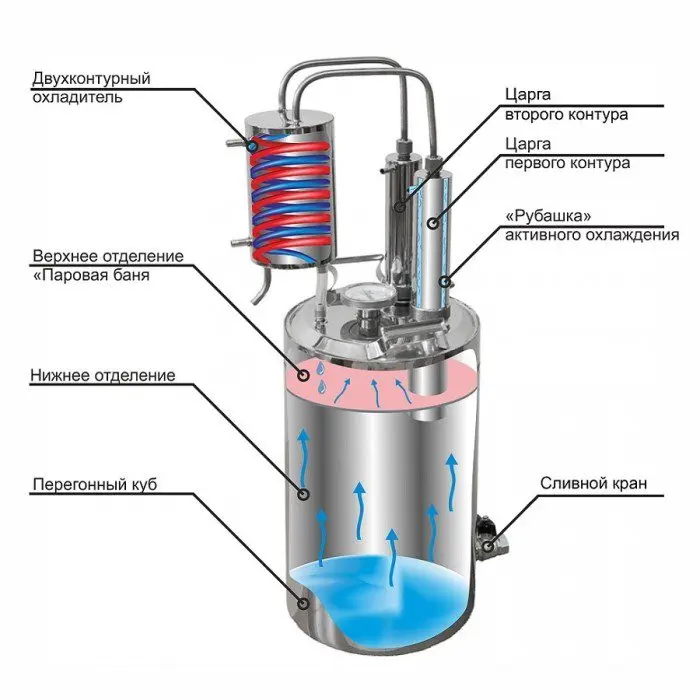
The modernization of the device went along the knurled path, without affecting the solution of the main problems, the manufacturers only concentrated on introducing new fashionable details into the circuit.
Design flaws
It has long been a classic rule: the first distillation should be carried out at maximum speed, so that less hard-to-remove harmful impurities are formed during cooking. This device completely contradicts this principle.
The moonshine evaporated from the mash, heating the steam bath, condenses on its bottom, then flows back into the mash for further “enrichment” with aldehydes, ethers, unsurpassed nitrogen-sulfur odors and other fruits of yeast boiled in an acidic environment. The process is repeated several times.
The newly expelled moonshine is not sent for re-distillation, but is poured back into the cube – right into the smelly stillage, and distilled again. How much worse will the drink be after the second time? And after the third? Here, even a novice moonshiner will feel the possible difference with his skin without such a mockery of the product.
And why after 2-3 times? Let’s talk without higher mathematics: what heats the upper container? That’s right – steam. Since the molar heat of vaporization and condensation of alcohol and water is the same, in order for one molecule of water or alcohol to evaporate in the upper container, one molecule must be condensed in the lower container. To do this, you will have to cook moonshine at least twice in the lower tank so that it gets and evaporates once from the top.
This is very bad, but once again the playful hands of the innovators itched – and it got even worse. The next modernization brought to the first and second circuits a drawer with a water jacket, or even with a shell and tube. Because it’s not enough to brew moonshine 2 times, you still need to repeatedly return it to the cube to the mash so that it doesn’t leave the container the first time. The process began to be repeated not two, but three or four times … Maybe more, because the water supply to the dephlegmator side is not regulated or controlled in any way. Even if you install a faucet, where can you see the result of the adjustment or at least the amount of phlegm returned? The question is rhetorical, and the answer is simple – no one even bothered with it.
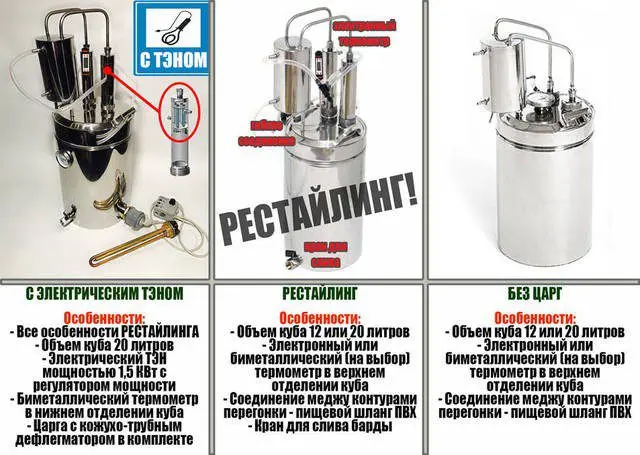
And the way to supply water to the drawers with a shirt reflux condenser is the worst – the water supply from below. Part of the steam immediately condenses and falls into the wash. There is no benefit, and the harm from additional cooking of mash and the useless expenditure of energy for this event is obvious.
It is worth paying attention to the selection of “heads”. Manufacturers of double-distillation moonshine stills recommend selecting “heads” through a tube connecting the cooler to the second tank. At first glance, everything is correct – this is also the case with simple distillation, but let’s look again: with traditional distillation, the first distillation is done quickly, without the selection of “heads” and “tails”. The reason is that during the drop-by-drop selection of “heads” they are selected less than during this time it is again formed in the cube. Therefore, the division into fractions on the classical apparatus is done during the second stage.
On double distillation apparatus, it is useless to select “heads” after the second tank, since they will be welded on and fed into it from the first tank throughout the entire haul, even as part of the “tails”. The head fraction is easily evaporated, no dephlegmators will delay it. This means that the product from the double distillation apparatus will not just be “heady”, but extremely enriched with all head impurities. Simply out of competition!
Moonshine, which, after repeated re-evaporation and boiling for many hours, into the upper tank, is, by definition, worse and dirtier than a similar product that has undergone a simple single distillation.
Apparently, after receiving negative reviews, the manufacturer in the latest modification of the device, called “Alcohol 2”, changed the sides, putting an empty side-sucker at the exit from the first container, which somewhat reduced the return of moonshine back to the mash. But here, too, the “designers” filled the drawer without a dephlegmator with Panchenkov’s nozzle – well, just a circus!

It would not be out of place to remind manufacturers of double distillation moonshine that a regular wire nozzle (OLTC) is not a filter, but an element that increases the area of uXNUMXbuXNUMXbcontact between steam and reflux. For the on-load tap-changer to work, you need a dephlegmator that creates a flow of phlegm towards the steam! In a dry steamer, it only carries a marketing burden, making it easier to sell this model to beginners.
Attempts to imitate a packed column with a reflux condenser at the outlet of the second vessel also look no better. With a dwarf height, the nozzle is not able to somehow contain the fuselage. Impurities simply do not fit into a short pipe, and quickly reaching a critical concentration, they cheerfully fly into the selection. These mini drawers are important only for advertising purposes, they give the device solidity and increase the price.
When distilling on a standard BC, the height of the drawer is from 750 mm and above, while everyone understands that it is unrealistic to get alcohol without increasing the height to 100-150 cm. Immediately, just one wad from the on-load tap-changer gives the manufacturer a reason to talk about the device as a spirit brewer, and call the product almost alcohol.
Another myth, carefully pushed into the mind of the consumer, is the claim that such an apparatus saves twice the time compared to two consecutive distillations.
Deplorably low productivity – according to the passport up to 600-700 ml / h, and according to the reviews of the owners – about 400 ml / h intelligibly answers the manufacturer’s statement about saving time. On a conventional apparatus, during the same time, you can not only do the first and second distillation, but also have time to drink, eat, and then also take the children to the zoo. Moreover, on different sites, information about the performance of the same one changes: from 0,6 l / h to 1 l / h, and on the most deceitful resources – up to 3 l / h. Looks like they’re not buying well.
A photo from the production of moonshine stills of double distillation got into the network, where a five-turn cooler coil is visible, which definitely cannot cope with a power above 1 l / h. So let’s focus on honest “up to 600 ml / hour.” Moreover, it is precisely this distillation rate that the Chelyabinsk Distillation Apparatus Plant lists on its website. Dealers and just small sellers have less faith.
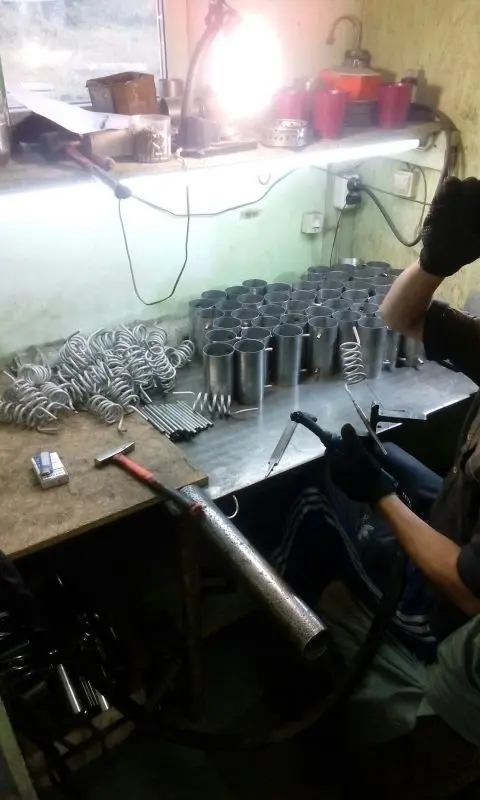
In general, the normal distillation capacity of a conventional apparatus is approximately twice the heating power. If you apply 1,5 kW for heating, then you should wait for about 3 l / h of the selection rate – this is the standard. But if you get 600 ml / hour – money down the drain. 5 times lower speed, even taking into account the simultaneous double distillation – 2,5 times more water and electricity (gas) consumption.
Consider a simple example: if 4 liters of a product of 75% strength can be obtained from the contents of a cube, then at a rate of 600 ml / hour it will take 6,7 hours without taking into account the heating time. To expel the same amount of product in a sequential distillation and the same heating power of 1,5 kW, the first distillation will take 1,8 hours, the second another 1,3 hours, for a total of 3,1 hours. Add time for heating: 2 times for 40 minutes, another 1,3 hours. We get 4,5 hours, taking into account other possible losses of time – 5 hours. No time savings for sure.
conclusions
- Manufacturers claim that the main advantage of such models is double distillation from one heating. Then what does the refrigerator do after the first container? That’s right, it turns all the steam into cold moonshine and pours it into the second tank, where the distillate is reheated and evaporated.
- Advertising assures that almost alcohol is obtained on the double distillation apparatus – a product of the highest purity. Above, we laid out on our fingers that the product will be dirtier than distillate even after traditional double distillation, and in terms of the amount of head impurities it is simply the industry leader.
- Another argument of manufacturers is a significant time saving for double distillation. But even if we take the passport data of the device, then there is no saving in comparison with traditional technology.
- Manufacturers claim that the apparatus is triple cleaned: on the tap changer in the dryer, in the upper tank due to dilution with water, and at the outlet of the second tank in the drawer with a dephlegmator. In fact, none of the cleaning steps work.
What to do for those who bought
Unfortunately, the double distillation moonshine is not subject to simple modernization. If less than 14 days have passed since the purchase, you can try to return the goods to the seller.
In terms of improvements, it is easiest for owners of the latest modifications with a saucepan and a steam chamber fixed on the lid. It is easy to dismantle the chamber, and instead put a simple once-through refrigerator on the cover. The increased heating power will allow you to enjoy a distillation speed of up to 8 l / h and improve the quality of moonshine to an acceptable level.
PS Realizing the impasse of the situation, manufacturers have massively switched to the production of second-generation double distillation apparatuses. These are such models as “Hmel-master-3”, “Hurricane”, “Double-barrel”, “Siberia 3”, “Baikal”, “Robin Bootleger”, the latest products of “Gorilych”, etc. Although these devices also do not solve the problem of welding a large number of “heads” and the impossibility of their selection, they certainly are a step forward in relation to the first generation. Each of these structures is interesting in its own way, and therefore deserves special attention.
The author of the review is IgorGor.









